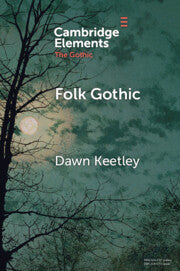Folk Gothic
- Unit price
- / per
-
Author:KEETLEY Dawn
-
ISBN:9781009160896
-
Publication Date:February 2024
-
Edition:1
-
Pages:78
-
Binding:Paperback
-
Publisher:Cambridge University Press
-
Country of Publication:United Kingdom


Folk Gothic
- Unit price
- / per
-
Author:KEETLEY Dawn
-
ISBN:9781009160896
-
Publication Date:February 2024
-
Edition:1
-
Pages:78
-
Binding:Paperback
-
Publisher:Cambridge University Press
-
Country of Publication:United Kingdom
Description
Folk Gothic begins with the assertion that a significant part of what has been categorised as folk horror is more accurately and usefully labelled as Folk Gothic. Through the modifier 'folk', Folk Gothic obviously shares with folk horror its deployment (and frequent fabrication) of diegetic folklore. Folk Gothic does not share, however, folk horror's incarnate monsters, its forward impetus across spatial and ontological boundaries and the shock and repulsion elicited through its bodily violence. The author argues that the Folk Gothic as a literary, televisual and cinematic formation is defined by particular temporal and spatial structures that serve to forge distinctly nonhuman stories. In emphasising these temporal and spatial structures – not literal 'folk' and 'monsters' – the Folk Gothic tells stories that foreground land and 'things', consequently loosening the grip of anthropocentrism.
Adding product to your cart
You may also like
You may also like
You may also like
-
Folk Gothic begins with the assertion that a significant part of what has been categorised as folk horror is more accurately and usefully labelled as Folk Gothic. Through the modifier 'folk', Folk Gothic obviously shares with folk horror its deployment (and frequent fabrication) of diegetic folklore. Folk Gothic does not share, however, folk horror's incarnate monsters, its forward impetus across spatial and ontological boundaries and the shock and repulsion elicited through its bodily violence. The author argues that the Folk Gothic as a literary, televisual and cinematic formation is defined by particular temporal and spatial structures that serve to forge distinctly nonhuman stories. In emphasising these temporal and spatial structures – not literal 'folk' and 'monsters' – the Folk Gothic tells stories that foreground land and 'things', consequently loosening the grip of anthropocentrism.
-
-
Author: KEETLEY DawnISBN: 9781009160896Publication Date: February 2024Edition: 1Pages: 78Binding: PaperbackPublisher: Cambridge University PressCountry of Publication: United Kingdom
Folk Gothic begins with the assertion that a significant part of what has been categorised as folk horror is more accurately and usefully labelled as Folk Gothic. Through the modifier 'folk', Folk Gothic obviously shares with folk horror its deployment (and frequent fabrication) of diegetic folklore. Folk Gothic does not share, however, folk horror's incarnate monsters, its forward impetus across spatial and ontological boundaries and the shock and repulsion elicited through its bodily violence. The author argues that the Folk Gothic as a literary, televisual and cinematic formation is defined by particular temporal and spatial structures that serve to forge distinctly nonhuman stories. In emphasising these temporal and spatial structures – not literal 'folk' and 'monsters' – the Folk Gothic tells stories that foreground land and 'things', consequently loosening the grip of anthropocentrism.
-
Author: KEETLEY DawnISBN: 9781009160896Publication Date: February 2024Edition: 1Pages: 78Binding: PaperbackPublisher: Cambridge University PressCountry of Publication: United Kingdom
-




